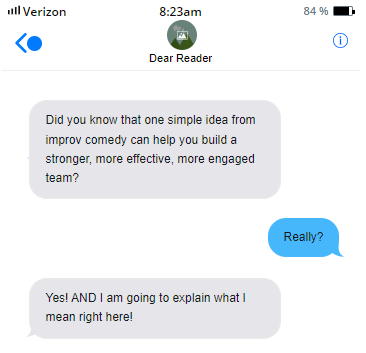
"Yes, and" is a powerful phrase that has its roots in improv comedy. It is used to build on the ideas of others and create a collaborative and dynamic scene.
(If you are unfamiliar with the idea of saying “yes, and” instead of “yes, but,” you must be new to my content - welcome! You can check out my book or TEDx talk to learn more about it.)
In the business world, "yes, and" can be used to respond to change in a positive and productive way. When faced with a new challenge or opportunity, a "yes, and" mindset allows us to see the possibilities and opportunities rather than the limitations and obstacles.
But "yes, and" is not only beneficial for communication and innovation, it can also play a key role in building psychological safety in the workplace.
Psychological safety refers to an environment in which individuals feel safe to express themselves, share ideas, and take risks without fear of negative consequences. It is a crucial aspect of any organization, as it allows for open communication, creativity, and learning. According to an internal Google study, psychological safety is the #1 factor in determining team success.
As the pioneer of the topic Harvard Business School Professor Amy Edmondson explains, "Psychological safety is the belief that one will not be punished or humiliated for speaking up with ideas, questions, concerns, or mistakes."
Creating psychological safety is not easy, but "yes, and" can be a powerful tool to help leaders and managers establish a psychologically safe environment. Here are three specific “yes, and” techniques you can use to create psychological safety for your employees:
Encourage open-minded listening: By using “yes, and” to listen to and build upon the ideas of others rather than using “yes, but” to criticize and point out why the other person is wrong or that the idea is flawed, leaders and managers can create an environment in which employees feel safe to express themselves and share ideas.
Embrace the unknown: Edmondson explains in her TEDx talk that psychological safety is critically important when there is a high degree of uncertainty. As I talk about in my keynote presentations, when people say, “yes, but” they are often resisting the unknown. By encouraging your employees to say “yes, and” you are encouraging and supporting them to embrace the unknown. Also, when you say, “yes, and” to the unknown you foster a curious mindset rather than a “must succeed” one, which creates a greater sense of psychological safety.
Have fun: Failure and mistakes aren’t fun, per se, but when employees know you will look at them as learning opportunities and even be able to laugh at unintended outcomes, their sense of comfort and psychological safety goes up. You’ll still need accountability and correction, but that doesn’t mean everything needs to be doom and gloom.
Psychological safety is essential for any organization looking to foster open communication, creativity, and learning. As a leader or manager, "yes, and" can be a powerful tool for building psychological safety because it encourages active listening, embracing the unknown, and incorporating fun and interactive activities. By creating a safe environment where employees feel comfortable expressing themselves, organizations can succeed and thrive.
